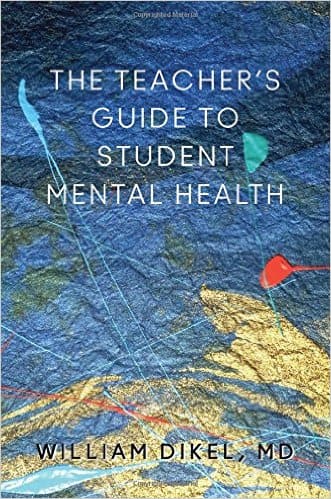July 23, 2015
By Jacob Bradshaw

The Teacher's Guide to Student Mental Health
By William Dikel M.D.
Nortan's Books in Education (2014)
For educational professionals seeking advice and direction on how to support students with mental health conditions, The Teacher’s Guide to Student Mental Health is a great resource. The guide has a bit of a textbook feel to it, but the writing is clear and accessible, and colorful “vignettes” provide miniature case studies.
Author William Dikel, M.D., discusses the concept of the clinical-behavioral spectrum, a straightforward framework for understanding the relationship between mental health and behavior, and differentiating between willful, controlled behavior and that which is a direct result of mental illness.
On the clinical end of the spectrum are actions that derive directly from a mental health condition. For example, if a child has major depressive disorder, and does not interact with other students, their behavior is likely a result (at least partially) of their depression. Trying to coax them into not being “shy” wouldn’t be an effective solution.
The behavioral end of the spectrum might include a child who frequently throws tantrums but doesn’t otherwise exhibit signs of a mental health condition. Dr. Dikel explains that psychiatric treatment is not needed. Rather, behavioral intervention (disciplinary techniques, for example) is instead called for.
For many individuals, some of their actions may be partly clinical and partly behavioral, or some of their actions may be clinical and other actions behavioral. Dr. Dikel stresses that it is important not to make assumptions about the cause of certain difficulties without considering both clinical and behavioral factors.
The next section of the book is a thorough look at various mental health concerns common among youth, including diagnostic criteria, symptoms, and available treatments. The list is not exhaustive but it as an introduction to the field it is quite complete and covers all the major focuses of adolescent mental health.
Dikel then moves into the heart of the book: a guide to working with students who have mental health conditions. He examines teaching strategies, accommodations, and special education programs in relation to different mental health conditions. This includes descriptions of various school officials and mental health professionals and their potential role in the education mental health system. The book also includes advice and information on effective communication strategies between parents and school staff, 504 and special education plans, and even the potential value of technology in working with students who have a mental illness.
Appendices include a detailed explanation of comprehensive mental health evaluations, information on various therapy methods for adolescents, and a discussion on the appropriate use of medication, in particular for children. Dr. Dikel warns against prescribing medication for symptoms that result from environmental factors—for example, a child with abusive parents is likely to be unhappy and stressed – or that result from physical conditions such as malnutrition, and supports the use of medication in many situations while also endorsing non-medicinal therapy.
The Teacher’s Guide is overall an excellent resource and a well-written book. Certain sections could be expanded a little more. For example, some of these vignettes end in a series of questions without a complementary list of answers, and sometimes Dr. Dikel mentions situations where parents and the school may disagree but doesn’t provide advice on how to resolve such a dispute. Nevertheless, as an entry-level text The Teacher’s Guide covers what it needs to cover, and it does so in a very readable manner.
Submit To The NAMI Blog
We’re always accepting submissions to the NAMI Blog! We feature the latest research, stories of recovery, ways to end stigma and strategies for living well with mental illness. Most importantly: We feature your voices.
LEARN MORE